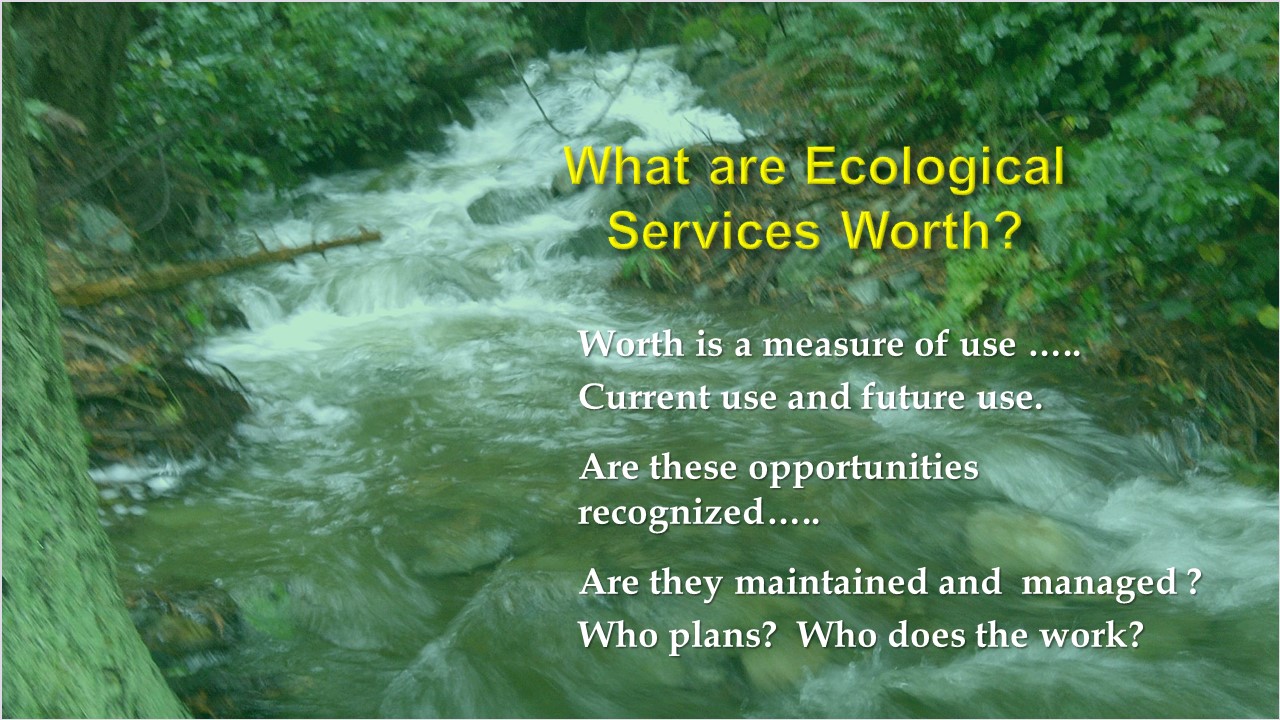Ecological Accounting Process and Water Balance Methodology – the twin pillars of a whole-system, water balance vision for restorative land development in British Columbia, an approach branded as “Sustainable Watershed Systems, through Asset Management”
Note to Reader:
A new way of thinking about municipal infrastructure has the attention of the local government world. No longer is asset management only about hard engineered assets – watermains, sewers, roads. Watershed systems are also “infrastructure assets”.
Already facing a $200 billion challenge for renewal of hard infrastructure, Asset Management for Sustainable Service Delivery: A BC Framework provides a financial driver for local governments in British Columbia to integrate a whole-system, water balance approach and climate adaptation into asset management.
The BC Framework sets a strategic direction that would refocus business processes on outcomes that reduce life-cycle costs and risks. Use less water. Mimic natural flows in streams. Preserve the natural pathways by which water reaches streams. Slow, spread and absorb runoff. Benefits include less flooding, less stream erosion, more streamflow when needed most.
Inter-governmental collaboration and funding enable the Partnership for Sustainability in British Columbia to collaborate with others to develop (and share) approaches, tools and resources; as well as provide teaching, training and mentoring. EAP, the Ecological Accounting Process, is one of the Partnership’s numerous initiatives. EAP aligns with and supports the BC Framework.
The educational goal of the Partnership is to build practitioner capacity within the local government setting to implement a whole-system, water balance approach branded as Sustainable Watershed Systems, through Asset Management.

A Short History
“Development of the Ecological Accounting Process (EAP) began in 2015. The EAP vision was first unveiled in Beyond the Guidebook 2015: Moving Towards “Sustainable Watershed Systems, through Asset Management”, released in November 2015. This was the third in a series that builds on Stormwater Planning: A Guidebook for British Columbia, released by the provincial government in 2002,” states Kim Stephens, Executive Director, Partnership for Water Sustainability in BC. He was the author of Beyond the Guidebook 2015.
 “Beyond the Guidebook 2015 introduced the notion of the ‘twin pillars’ – that is, EAP and the Water Balance Methodology – for asset management strategies that achieve the goal of “sustainable watershed systems”. The stated objective for EAP at the time was: address the challenge of determining financial values for goods and services drawn from natural systems.
“Beyond the Guidebook 2015 introduced the notion of the ‘twin pillars’ – that is, EAP and the Water Balance Methodology – for asset management strategies that achieve the goal of “sustainable watershed systems”. The stated objective for EAP at the time was: address the challenge of determining financial values for goods and services drawn from natural systems.
“In the concluding chapter of Beyond the Guidebook 2015, in a foreshadowing of what was to come, we stated that the best blend of engineered assets (infrastructure) and natural assets (that provide ecological goods and services) would support a robust long-term asset management plan and the required financial commitments.
“Months later, an article titled Getting the Most from Infrastructure Assets: The Idea of Ecological Accounting began the process of explaining the EAP concept. The article was published in the Winter (February) 2016 issue of the Asset Management BC Newsletter.
“This article discussed the importance of devising an ecological accounting protocol and the valuation issues that arise. It was the first in a 2-part series. The focus of the second, published in September 2016, was on how the protocol would enable full risk and opportunity assessment of all assets owned by and available to local government.
“Context is everything. Thus, one should view EAP as representing one point along a ‘green infrastructure continuum’. It is the latest evolution in an ongoing process in British Columbia that had its genesis circa 1990. EAP has evolved since the idea was first conceived in 2015. EAP continues to evolve through an ongoing process of demonstration applications. Our mantra is – do, learn, adapt and do better,” concludes Kim Stephens.
To Learn More:

Ecological Accounting: “The emphasis is on ‘civil services’ that provide a municipal function,” wrote Tim Pringle in February 2016
Tim Pringle coined the phrase ecological accounting procss to make clear the distinction vis-à-vis ecological economics. “The purpose of EAP is to enable comparison of engineered infrastructure to natural systems by means of common units of measurement and value,” stated Tim Pringle in the first Asset Management BC article.
“Ecological accounting differs from ecological economics. The latter approach determines general values for natural systems with emphasis on influencing policy and statistical measures. The former process determines which infrastructure services may be drawn from natural assets and the cost of using those services at specific sites and throughout a watershed.
“There appears to be little existing research to describe the cost of managing natural assets compared to engineered assets. Ecological accounting faces the challenge of monetizing natural assets and services in a way that can be compared to engineered assets and services.”
Ecological Accounting: “It would allow Asset Managers and Owners to see a more complete picture of value and future costs,” wrote Tim Pringle in September 2016
“EAP is an economic tool to make real the notion of ‘watersheds as infrastructure assets’. Practitioners would use it to determine whether or not drawing services from natural assets for drainage infrastructure makes financial sense. It would enable practitioners to price expenditures or avoided expenditures that occur in such contexts,” explained Tim Pringle in the second article published by Asset Management BC.
“It follows that potential capital expenditures for engineered services and those drawn from natural assets could be compared. Practitioners could determine the optimum balance of these options. Such design of infrastructure services offers enhanced protection of watershed hydrology (and ecology) as well as lower life-cycle costs for the assets.”
“It would make sustainable service delivery more robust with the inclusion of the value and costs associated with the use of services from natural assets to supply infrastructure.”
“EAP is a process, not a protocol,” stated Tim Pringle in November 2017 at the Blue Ecology Workshop
“The vision for EAP is that it would help local governments in British Columbia progress along the Asset Management Continuum for Sustainable Service Delivery. Once a life-cycle approach is standard practice, the next logical step is to integrate ecological services from natural systems into asset management,” stated Tim Pringle.
“Initially, we saw EAP as a tool (i.e. ‘the protocol’) that would help practitioners calculate the opportunity cost of balancing ecological services with drainage infrastructure. However, our thinking has evolved over the past year. Testing the approach through two demonstration applications has resulted in this defining conclusion: EAP is a process, not a protocol. Thus, we are re-branding EAP as the Ecological Accounting Process.
“This is one of two early conclusions. The second relates to the distinction between worth and value.”
A Process, not a Protocol
“The term ‘Process’ more accurately describes the challenge of working with multiple stakeholders to assess the hydrology of an entire creekshed, or small watershed, in order to accurately describe the ecological services made possible by the hydrology,” explained Tim Pringle.
“This comprehensive approach rarely takes place and it makes the Ecological Accounting Process (EAP) unique.”
Worth versus Value
“Stakeholders have, by the nature of their engagement in dealing with hydrological and ecological concerns in a creekshed, confirmed what is or is not worthwhile to them,” continued Tim Pringle.
“Looking through the ‘worth lens’ led us to a fundamental shift in approach. The EAP methodology now places less emphasis on the monetization of ecological services. Instead, the principal focus is on the investment of resources already made by many stakeholders, as well as their aspirations concerning the management (prevention of degradation to and work on enhancement) of ecological services in the creekshed.”
TO LEARN MORE:
Download a 4-page booklet titled An Introduction to the Ecological Accounting Process (EAP).
Download a copy of the Primer on the Ecological Accounting Process (EAP) – A Methodology for Valuing the ‘Water Balance Services’ Provided by Nature, released in January 2019.



